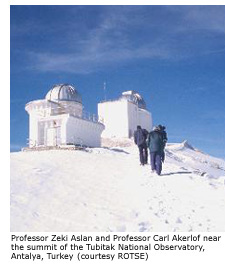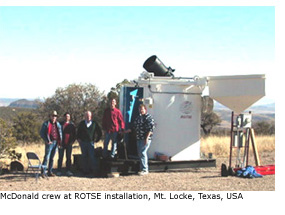|
|
Gamma Ray Burst Astronomy Opens New Chapter at
McDonald
3 February 2003
Austin, TX --The second of four planned telescopes for the Robotic Optical Transient Search
Experiment (ROTSE IIIb) has seen first light at McDonald Observatory.
The equipment is dedicated to
the detection and observation of optical transients, flashes in the night sky that last only seconds, days or weeks.
Of primary interest are gamma ray bursts, fantastically bright, almost unimaginably distant, brief explosions.
The ROTSE network will circle the earth. ROTSE IIIa is being brought on line in Australia. IIIc and IIId will be
installed in Namibia and Turkey. The rapid response, robotic telescopes, will together have 24-hour,
ground-based, night sky access both for follow up observations and discovery. The
system responds to satellite-based gamma ray burst triggers, and to variations discovered directly by the ROTSE
instruments.
 The mysterious gamma ray burst events were first discovered by accident in the late 1960's.
Their random occurence, and short duration of just a few seconds up to about a minute,
makes them extremely difficult to study. After more than 30 years, their origin and nature
remains largely an enigma. Data gathered from optical observations of the afterglow
of these events has led to reasonable determination of their power and location. One burst has
been estimated to represent the power of nearly ten million billion suns.
The mysterious gamma ray burst events were first discovered by accident in the late 1960's.
Their random occurence, and short duration of just a few seconds up to about a minute,
makes them extremely difficult to study. After more than 30 years, their origin and nature
remains largely an enigma. Data gathered from optical observations of the afterglow
of these events has led to reasonable determination of their power and location. One burst has
been estimated to represent the power of nearly ten million billion suns.
The mission of the ROTSE Project, is to enable ground-based observation of transients within 10 seconds
of their detection. The system is fully automated, and responds to triggers placed aboard
orbiting instruments, such as the High Energy Transient Explorer (HETE-2) and Swift satellites (see inset links).
The alert system is called the Gamma Ray Burst Coordinate Network (GCN).
On receiving a GCN alert, ROTSE telescopes begin a programmed series of exposures at increasing intervals
to record both events and their afterglow.
In October of 2002, The HETE sent out a burst alert of the event GRB021004. The alert was sent within 11 seconds
of detection to observatories on the ground, and accurate coordinates followed at 48 seconds, while the event
was still in progress. The detection led to the best observations to date of a burst event. In the
days following, more than 100 telescopes in 11 countries participated in follow up observations, including
Hubble and the Chandra X-ray Observatory.
An event of shorter duration was caught in December of 2002. Again, the HETE transmitted
coordinates to instruments worldwide. Observations were made within 65 seconds, capturing what has been classified
as a "dark" burst, because no afterglow of these more brief explosions had yet been observed. "Dark" bursts are of
the shortest known duration, reportedly lasting about 2.5 seconds. This event is estimated to have occurred at a
distance of 6 billion light years, nearly half the estimated age of the universe.
Given the difficulty of obtaining data, explanations of powerful transients are tentative. Astronomers believe they
could result from the creation of black holes, or perhaps the collision of neutron stars, which would also result in
a black hole.
 The ROTSE Project is an international collaboration of astrophysicists from the University of Michigan,
Los Alamos National Laboratory, Lawrence Livermore National Laboratory, the University of New South
Wales (Australia), the Max Planck Institute for Nuclear Physics (Germany), and the University of Texas,
and has received funding from NASA, NSF, The Research Corporation, and the Australian Research Council.
The principal investigator is Professor Carl Akerlof of Michigan.
The ROTSE Project is an international collaboration of astrophysicists from the University of Michigan,
Los Alamos National Laboratory, Lawrence Livermore National Laboratory, the University of New South
Wales (Australia), the Max Planck Institute for Nuclear Physics (Germany), and the University of Texas,
and has received funding from NASA, NSF, The Research Corporation, and the Australian Research Council.
The principal investigator is Professor Carl Akerlof of Michigan.
Data from ongoing ROTSE observations are available via the world wide web at the ROTSE home page.
Plans have been made to integrate the ROTSE-III equipment and software into an educational tool for
college freshmen.
The new instrument at McDonald has been dedicated to the memory of the crew of the shuttle Colombia.
more news..
|
|

 The mysterious gamma ray burst events were first discovered by accident in the late 1960's.
Their random occurence, and short duration of just a few seconds up to about a minute,
makes them extremely difficult to study. After more than 30 years, their origin and nature
remains largely an enigma. Data gathered from optical observations of the afterglow
of these events has led to reasonable determination of their power and location. One burst has
been estimated to represent the power of nearly ten million billion suns.
The mysterious gamma ray burst events were first discovered by accident in the late 1960's.
Their random occurence, and short duration of just a few seconds up to about a minute,
makes them extremely difficult to study. After more than 30 years, their origin and nature
remains largely an enigma. Data gathered from optical observations of the afterglow
of these events has led to reasonable determination of their power and location. One burst has
been estimated to represent the power of nearly ten million billion suns.
 The ROTSE Project is an international collaboration of astrophysicists from the University of Michigan,
Los Alamos National Laboratory, Lawrence Livermore National Laboratory, the University of New South
Wales (Australia), the Max Planck Institute for Nuclear Physics (Germany), and the University of Texas,
and has received funding from NASA, NSF, The Research Corporation, and the Australian Research Council.
The principal investigator is Professor Carl Akerlof of Michigan.
The ROTSE Project is an international collaboration of astrophysicists from the University of Michigan,
Los Alamos National Laboratory, Lawrence Livermore National Laboratory, the University of New South
Wales (Australia), the Max Planck Institute for Nuclear Physics (Germany), and the University of Texas,
and has received funding from NASA, NSF, The Research Corporation, and the Australian Research Council.
The principal investigator is Professor Carl Akerlof of Michigan.